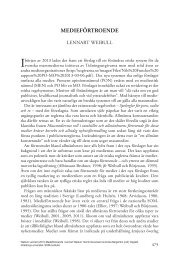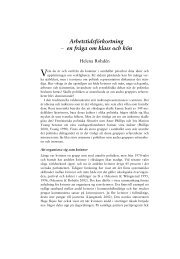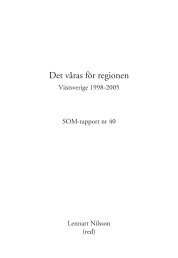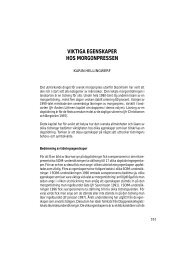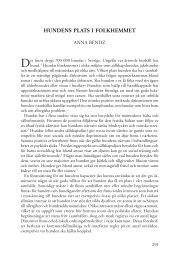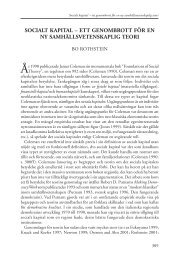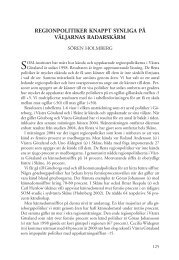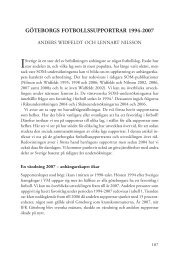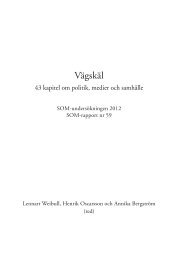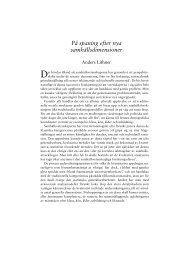- Page 1 and 2:
Det våras för politiken Trettiotv
- Page 3 and 4:
Redaktörer: Sören Holmberg och Le
- Page 5 and 6:
Jan Strid Radiolyssnandet 2001 - en
- Page 8 and 9:
Förord FÖRORD Det våras för pol
- Page 10 and 11:
Det våras för politiken DET VÅRA
- Page 12 and 13:
Det våras för politiken 2001. Ock
- Page 14 and 15:
Det våras för politiken Samhälls
- Page 16 and 17:
Det våras för politiken andelen s
- Page 18 and 19:
Det våras för politiken Figur 4 N
- Page 20 and 21:
Det våras för politiken Figur 5 P
- Page 22 and 23:
Det våras för politiken Medeltal
- Page 24 and 25:
Det våras för politiken Han var e
- Page 26 and 27:
Det våras för politiken Figur 6 M
- Page 28 and 29:
Tabell 5 Andel av svenska folket so
- Page 30 and 31:
Det våras för politiken Tabell 6
- Page 32 and 33:
Det våras för politiken När det
- Page 34:
Ett år i politiken
- Page 37 and 38:
Sören Holmberg och Lennart Weibull
- Page 39 and 40:
Sören Holmberg och Lennart Weibull
- Page 41 and 42:
Sören Holmberg och Lennart Weibull
- Page 43 and 44:
Sören Holmberg och Lennart Weibull
- Page 45 and 46:
Sören Holmberg och Lennart Weibull
- Page 47 and 48:
Sören Holmberg och Lennart Weibull
- Page 49 and 50:
Sören Holmberg och Lennart Weibull
- Page 51 and 52:
50 Tabell 6 Mycket eller ganska hö
- Page 53 and 54:
Sören Holmberg och Lennart Weibull
- Page 55 and 56:
Sören Holmberg och Lennart Weibull
- Page 57 and 58:
Sören Holmberg och Lennart Weibull
- Page 60 and 61:
Flernivådemokrati och välfärdspo
- Page 62 and 63:
Flernivådemokrati och välfärdspo
- Page 64 and 65:
Flernivådemokrati och välfärdspo
- Page 66 and 67:
Flernivådemokrati och välfärdspo
- Page 68 and 69:
Flernivådemokrati och välfärdspo
- Page 70 and 71:
Flernivådemokrati och välfärdspo
- Page 72 and 73:
Flernivådemokrati och välfärdspo
- Page 74:
Flernivådemokrati och välfärdspo
- Page 77 and 78:
Sören Holmberg Figur 1 Svenska fol
- Page 79 and 80:
Sören Holmberg Tabell 1 Sambandet
- Page 81 and 82:
80 Figur 3 Svenska folket placerar
- Page 83 and 84:
Sören Holmberg Tabell 3 Partisympa
- Page 86 and 87:
Partierna väljer sina väljare PAR
- Page 88 and 89:
Partierna väljer sina väljare av
- Page 90 and 91:
Partierna väljer sina väljare Bla
- Page 92 and 93:
Partierna väljer sina väljare Fyr
- Page 94 and 95:
Partierna väljer sina väljare Med
- Page 96 and 97:
Partierna väljer sina väljare tio
- Page 98 and 99:
Partierna väljer sina väljare Fig
- Page 100 and 101:
Partierna väljer sina väljare Fig
- Page 102 and 103:
Partierna väljer sina väljare Fol
- Page 104 and 105:
Tabell 5 Andel som anser att olika
- Page 106 and 107:
Partierna väljer sina väljare kom
- Page 108:
Partierna väljer sina väljare Osc
- Page 111 and 112:
Maria Oskarson och Helena Rohdén S
- Page 113 and 114:
Maria Oskarson och Helena Rohdén i
- Page 115 and 116:
Maria Oskarson och Helena Rohdén
- Page 117 and 118:
Maria Oskarson och Helena Rohdén
- Page 119 and 120:
Maria Oskarson och Helena Rohdén F
- Page 121 and 122:
Maria Oskarson och Helena Rohdén P
- Page 123 and 124:
Maria Oskarson och Helena Rohdén o
- Page 125 and 126:
Maria Oskarson och Helena Rohdén v
- Page 127 and 128:
Maria Oskarson och Helena Rohdén O
- Page 129 and 130:
Martin Brothén Förtroendet för r
- Page 131 and 132:
Martin Brothén Från tidigare stud
- Page 133 and 134:
Martin Brothén Tabell 2 Medborgarn
- Page 135 and 136:
Martin Brothén Figur 2 Procent 45
- Page 137 and 138:
Martin Brothén Tabell 3 Medborgare
- Page 139 and 140:
Martin Brothén 8 Det kan noteras a
- Page 141 and 142:
Martin Brothén Burton, S. & Blair,
- Page 144 and 145:
Nytt klimat för miljöpolitiken? N
- Page 146 and 147:
Nytt klimat för miljöpolitiken? T
- Page 148 and 149:
Nytt klimat för miljöpolitiken? m
- Page 150 and 151:
Nytt klimat för miljöpolitiken? V
- Page 152 and 153:
Nytt klimat för miljöpolitiken? R
- Page 154 and 155:
Nytt klimat för miljöpolitiken? o
- Page 156 and 157:
Nytt klimat för miljöpolitiken? m
- Page 158 and 159:
Medborgarnas demokratiuppfattningar
- Page 160 and 161:
Medborgarnas demokratiuppfattningar
- Page 162 and 163:
Medborgarnas demokratiuppfattningar
- Page 164 and 165:
Medborgarnas demokratiuppfattningar
- Page 166 and 167:
Medborgarnas demokratiuppfattningar
- Page 168 and 169:
Medborgarnas demokratiuppfattningar
- Page 170 and 171:
Medborgarnas demokratiuppfattningar
- Page 172 and 173:
Medborgarnas demokratiuppfattningar
- Page 174 and 175:
Medborgarnas demokratiuppfattningar
- Page 176 and 177:
Medborgarnas demokratiuppfattningar
- Page 178 and 179:
Medborgarna och den medialiserade p
- Page 180 and 181:
Medborgarna och den medialiserade p
- Page 182 and 183:
Medborgarna och den medialiserade p
- Page 184 and 185:
Medborgarna och den medialiserade p
- Page 186 and 187:
Medborgarna och den medialiserade p
- Page 188 and 189:
Medborgarna och den medialiserade p
- Page 190 and 191:
Medborgarna och den medialiserade p
- Page 192:
Ett år med medierna
- Page 195 and 196:
Therese Eriksson exempelvis deras f
- Page 197 and 198:
Therese Eriksson förändringar är
- Page 199 and 200:
Therese Eriksson Definitionen av re
- Page 201 and 202:
Therese Eriksson I tabell 3 kan vi
- Page 203 and 204:
Therese Eriksson Under de senaste f
- Page 205 and 206:
Therese Eriksson Men det är allts
- Page 207 and 208:
Therese Eriksson Tabell 6 Kvällsti
- Page 209 and 210:
Therese Eriksson I framtida läsvan
- Page 212 and 213:
Radiolyssnandet 2001 - en uppdateri
- Page 214 and 215:
Radiolyssnandet 2001 - en uppdateri
- Page 216 and 217:
Radiolyssnandet 2001 - en uppdateri
- Page 218 and 219:
Radiolyssnandet 2001 - en uppdateri
- Page 220 and 221:
TV-tittarnas programpreferenser och
- Page 222 and 223:
TV-tittarnas programpreferenser och
- Page 224 and 225:
TV-tittarnas programpreferenser och
- Page 226 and 227:
TV-tittarnas programpreferenser och
- Page 228 and 229:
TV-tittarnas programpreferenser och
- Page 230:
TV-tittarnas programpreferenser och
- Page 233 and 234:
Lennart Weibull Mätningen av medie
- Page 235 and 236:
Lennart Weibull Nilsson, 2002). Ten
- Page 237 and 238:
Lennart Weibull Svarsmönstret kan
- Page 239 and 240:
Lennart Weibull Också i fråga om
- Page 241 and 242:
Lennart Weibull I diskussionen av m
- Page 243 and 244:
Lennart Weibull Könsskillnaderna
- Page 245 and 246:
Lennart Weibull Djerf-Pierre, Monik
- Page 247 and 248:
Annika Bergström Figur 1 Tillgång
- Page 249 and 250:
Annika Bergström större utsträck
- Page 251 and 252:
Annika Bergström Som det ser ut id
- Page 253 and 254:
Annika Bergström på skolor och ar
- Page 255 and 256:
Annika Bergström har fått upp ög
- Page 257 and 258:
Annika Bergström allt både lägre
- Page 259 and 260:
Annika Bergström 11 Bergström (20
- Page 261 and 262:
Lowe Hedman inne i en konsolidering
- Page 263 and 264:
Lowe Hedman i månaden som bland mi
- Page 265 and 266:
Lowe Hedman Tabell 2 Internetanvän
- Page 267 and 268:
Lowe Hedman Närmare hälften av de
- Page 269 and 270:
Lowe Hedman Vilka läser tidningar
- Page 271 and 272:
Lowe Hedman Vem läser vad på nät
- Page 273 and 274:
Lowe Hedman De fyra grupperna skilj
- Page 275 and 276:
Lowe Hedman Hedman, Lowe, ”Långs
- Page 277 and 278:
Stina Bengtsson som menar att denna
- Page 279 and 280:
Stina Bengtsson strukturerat vardag
- Page 281 and 282:
Stina Bengtsson Tabell 3 Andel av f
- Page 283 and 284:
Stina Bengtsson ramar för mer kost
- Page 285 and 286:
Stina Bengtsson Tabellen visar en s
- Page 287 and 288:
Stina Bengtsson som ansågs som en
- Page 289 and 290:
Stina Bengtsson Noter 1 D v s den s
- Page 292:
Ett år av samhällsfrågor
- Page 295 and 296:
Johan Martinsson hur de tänker pol
- Page 297 and 298:
Johan Martinsson och att den de sen
- Page 299 and 300:
Johan Martinsson Det visar sig allt
- Page 301 and 302:
Johan Martinsson 2001. Detta svarsa
- Page 303 and 304:
Johan Martinsson förändringar i d
- Page 305 and 306:
Johan Martinsson Redan av figur 2 k
- Page 307 and 308:
Johan Martinsson Som exempel kan n
- Page 310 and 311:
Socialt kapital - ett genombrott f
- Page 312 and 313:
Socialt kapital - ett genombrott f
- Page 314 and 315:
Socialt kapital - ett genombrott f
- Page 316:
Socialt kapital - ett genombrott f
- Page 319 and 320:
Monika Djerf-Pierre och Birgitta Ni
- Page 321 and 322:
Monika Djerf-Pierre och Birgitta Ni
- Page 323 and 324:
Monika Djerf-Pierre och Birgitta Ni
- Page 325 and 326:
Monika Djerf-Pierre och Birgitta Ni
- Page 327 and 328:
Monika Djerf-Pierre och Birgitta Ni
- Page 329 and 330:
Monika Djerf-Pierre och Birgitta Ni
- Page 332 and 333:
Allt jämnare på kärnkraftsfronte
- Page 334 and 335:
Allt jämnare på kärnkraftsfronte
- Page 336 and 337:
Allt jämnare på kärnkraftsfronte
- Page 338 and 339:
Allt jämnare på kärnkraftsfronte
- Page 340 and 341:
Kärnavfall KÄRNAVFALL PER HEDBERG
- Page 342 and 343:
Kärnavfall AKA-utredningen och det
- Page 344 and 345:
Kärnavfall Tabell 3 Svenska folket
- Page 346 and 347:
Kärnavfall Tabell 5 Andel negativa
- Page 348 and 349:
Kärnavfall Resultaten visar att de
- Page 350 and 351:
Kärnavfall 2001, kan vi emellertid
- Page 352 and 353:
Synen på industrisamhället SYNEN
- Page 354 and 355:
Synen på industrisamhället Drygt
- Page 356 and 357:
Synen på industrisamhället Tabell
- Page 358 and 359:
Synen på industrisamhället Det fi
- Page 360 and 361:
Synen på industrisamhället Av mil
- Page 362 and 363:
De studerande och biblioteken DE ST
- Page 364 and 365:
De studerande och biblioteken Bibli
- Page 366 and 367:
De studerande och biblioteken stort
- Page 368 and 369:
De studerande och biblioteken Figur
- Page 370 and 371:
De studerande och biblioteken att f
- Page 372 and 373:
De studerande och biblioteken Tabel
- Page 374 and 375:
De studerande och biblioteken med
- Page 376 and 377: De studerande och biblioteken utbil
- Page 378 and 379: Samarbete och ökat förtroende SAM
- Page 380 and 381: Samarbete och ökat förtroende Tab
- Page 382 and 383: Samarbete och ökat förtroende Nä
- Page 384 and 385: Samarbete och ökat förtroende har
- Page 386: Samarbete och ökat förtroende Pro
- Page 390 and 391: En global fördelningspolitik? EN G
- Page 392 and 393: En global fördelningspolitik? för
- Page 394 and 395: En global fördelningspolitik? Tabe
- Page 396 and 397: En global fördelningspolitik? Pers
- Page 398 and 399: Våren dröjer i EU-politiken VÅRE
- Page 400 and 401: Våren dröjer i EU-politiken Figur
- Page 402 and 403: Tabell 1 Uppfattning om konsekvense
- Page 404 and 405: Våren dröjer i EU-politiken Hade
- Page 406: Våren dröjer i EU-politiken När
- Page 409 and 410: Lennart Weibull och Lennart Nilsson
- Page 411 and 412: Lennart Weibull och Lennart Nilsson
- Page 413 and 414: 412 Tabell 2 Andelen som bedömer t
- Page 415 and 416: Lennart Weibull och Lennart Nilsson
- Page 417 and 418: Lennart Weibull och Lennart Nilsson
- Page 419 and 420: Ulf Bjereld Sverige ska ansluta sig
- Page 421 and 422: Ulf Bjereld Tabell 3 Svenska folket
- Page 423 and 424: Ulf Bjereld stater” samt 70 proce
- Page 426: Ett vanligt år
- Page 431 and 432: Donald Granberg The data can be use
- Page 434 and 435: Umgänge över generationerna UMGÄ
- Page 436 and 437: Umgänge över generationerna av de
- Page 438 and 439: Umgänge över generationerna på m
- Page 440 and 441: Umgänge över generationerna fem i
- Page 442 and 443: En vanlig dag: om vardagsaktivitet
- Page 444 and 445: En vanlig dag: om vardagsaktivitet
- Page 446 and 447: En vanlig dag: om vardagsaktivitet
- Page 448 and 449: En vanlig dag: om vardagsaktivitet
- Page 450 and 451: En vanlig dag: om vardagsaktivitet
- Page 452 and 453: En vanlig dag: om vardagsaktivitet
- Page 454: En vanlig dag: om vardagsaktivitet
- Page 458 and 459: Den nationella SOM-undersökningen
- Page 460 and 461: Den nationella SOM-undersökningen
- Page 462 and 463: Den nationella SOM-undersökningen
- Page 464 and 465: Den nationella SOM-undersökningen
- Page 466 and 467: Den nationella SOM-undersökningen
- Page 468 and 469: Den nationella SOM-undersökningen
- Page 470 and 471: Den nationella SOM-undersökningen
- Page 472 and 473: FÖRFATTARNA Kent Asp, professor vi
- Page 474: Johan Martinsson, fil kand, är dok
- Page 477 and 478:
Publik- och utbudsanalys Sveriges T
- Page 480 and 481:
SAMHÄLLE OPINION MASSMEDIA 2001 IN
- Page 484 and 485:
SAMHÄLLE OPINION MASSMEDIA 2001 G
- Page 486 and 487:
VI BÖRJAR MED DIN MASSMEDIEANVÄND
- Page 488 and 489:
Fråga 10 Vilken eller vilka frågo
- Page 490 and 491:
Fråga 21 I debatten om demokratin
- Page 492 and 493:
Fråga 29 Allmänt sett, hur stort
- Page 494 and 495:
Fråga 36 Hur ställer Du Dig till
- Page 496 and 497:
Fråga 42 Vad anser Du om följande
- Page 498 and 499:
Fråga 52 Nedanstående lista omfat
- Page 500 and 501:
TEKNIKINNEHAV OCH INTERNET ________
- Page 502 and 503:
Fråga 66 Är Du medlem i Svenska K
- Page 504 and 505:
Fråga 72 Vilken är Din uppfattnin
- Page 506 and 507:
Fråga 82 Är Du man eller kvinna?
- Page 508 and 509:
Fråga 100 Du som för närvarande
- Page 511 and 512:
SAMHÄLLE OPINION MASSMEDIA Samhäl
- Page 513 and 514:
___________________________________
- Page 515 and 516:
Fråga 5 Har Du själv funderat på
- Page 517 and 518:
Fråga 14 Man talar ibland om att p
- Page 519 and 520:
Fråga 23 Nedan återfinns ett anta
- Page 521 and 522:
Fråga 32 Vilken TV-kanal tycker Du
- Page 523 and 524:
EU:S TOPPMÖTE I GÖTEBORG I JUNI 2
- Page 525 and 526:
TEKNIKINNEHAV OCH INTERNET ________
- Page 527 and 528:
FRITID ____________________________
- Page 529 and 530:
Fråga 66 Hur ofta har Du under de
- Page 531 and 532:
Fråga 77 Har Du egna barn och i s
- Page 533 and 534:
Fråga 93 Är Du medlem i någon fa
- Page 535:
ETT STORT TACK FÖR DIN MEDVERKAN!
- Page 538 and 539:
ISSN 0284-4788 SOM-INSTITUTETS RAPP
- Page 540 and 541:
SOM-rapport nr 18 Holmberg, Sören




